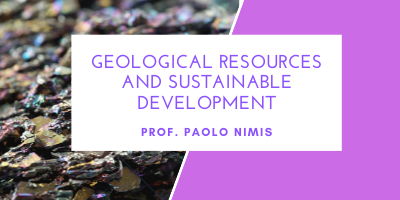Geological Resources and Sustainable Development

Period: first semester
Course unit contents:
1st Module - Mineral resources
This module will provide medium-depth knowledge of the geology and economic significance of ore deposits. For each deposit class, emphasis will be given to commodities for green development (e.g., REE, Li, Co, Ni, graphite for wind turbines, electric vehicles, energy storage, fuel-cells, LED’s; Cu, Pb, Mo, Ni, Zn, In, Sn, Ag, Te, Se, Ga, Cd, ultra-pure quartz for solar panels; etc.) and critical raw materials in general.
1. Elements of economic geology. Resources, reserves, deposits. Geological-economic parameters (tonnage, grade, cut-off grade, continuity, etc.). Classification of mineral resources. Elements of mining legislation in Italy and some foreign countries. Models of world’s mining production. Critical Raw Materials.
2. Magmatic ore deposits (with particular emphasis to Ni, Cu, Cr, PGE, V, Nb, Ta, REE, Li, ultra-pure quartz, diamond).
3. Hydrothermal ore deposits. 3.1. Linked to magmatic centres (Cu, Au, Mo, Sn, Zn, Pb, Ag, Te, Se, In). 3.2. Syn-orogenic, unrelated to magmatic centres (Au, Sb, Cu). 3.3. Syn-, dia- and epigenetic in sedimentary environments (Zn, Pb, Ag, Cu, Co, Cd, Ge).
4. Sedimentary ore deposits. 4.1. Hydrogenic (Fe, Na, K, B, P, Li). 4.2. Clastic (placers).
5. Supergenic ore deposits. 5.1. Residual (Al, Ga, Ni, REE). 5.2. Supergenic enrichments.
6. Other industrial rocks/minerals (fluorite, kaolin, bentonite, graphite, refractories, fluxes, fillers, abrasives, dimension and ornamental stones).
7. Sampling for exploration and evaluation. Estimation of grades and tonnages. Ore processing methods (mineralurgy).
8. Brief outline of underground, surface and underwater mining methods and of their environmental impact. Deep-sea mining and the International Seabed Authority. Examples of ‘green mining’. Recovery of minerals from mine wastes. Minerals in the circular economy.
9. Macroscopic and microscopic examination of the main metallic and industrial minerals and rocks.
2nd Module – Petroleum geology
This module will provide the key-concepts of petroleum geology, from source rock evaluation to production techniques, with a critical discussion about future development. Seminars on specific topics will be organized during the semester.
1. The origin of petroleum and physico-chemical properties of hydrocarbons. The Petroleum System.
2. Productivity and preservation of the organic matter. The kerogen and its transformation steps. The source rock: maturity of organic matter and source rock evaluation. Petroleum migration.
3. The reservoir. Physico-chemical properties; CO2 storage.
4. The seal.
5. Stratigraphic and structural traps. Salt and mud diapirs.
6. Statistical methods for estimating petroleum resources.
7. Main exploration and production techniques.
8. Unconventional resources: shale gas and oil, tight gas, coalbed methane, oil sands, gas hydrates. State-of-the-art and environmental impact.
9. Hydrocarbon reserves in Italy and in the world. The peak oil debate.
Planned learning activities and teaching methods: Taught lessons with the aid of powerpoint presentations and, in some cases, video materials. Lab classes (group work) will allow the macroscopic and microscopic examination of representative ore samples. A one-day field trip to a mining site will be scheduled during the first module.